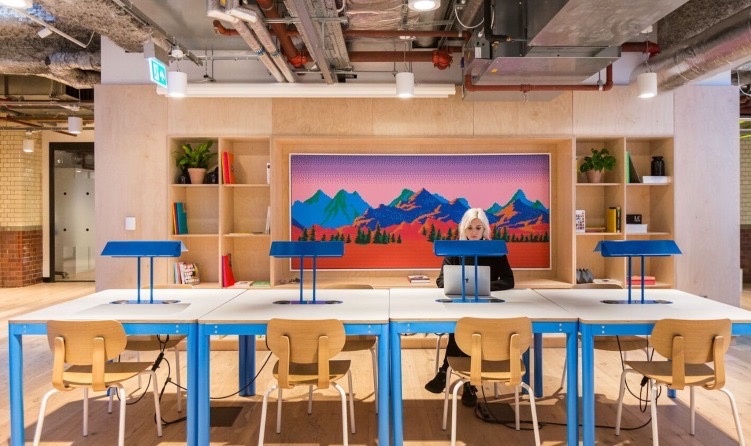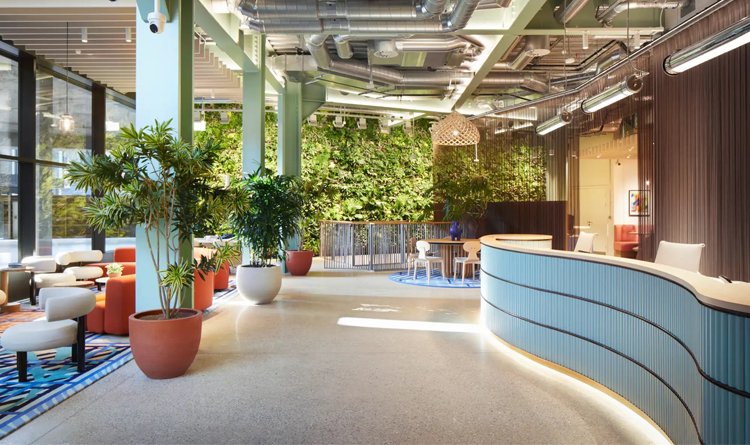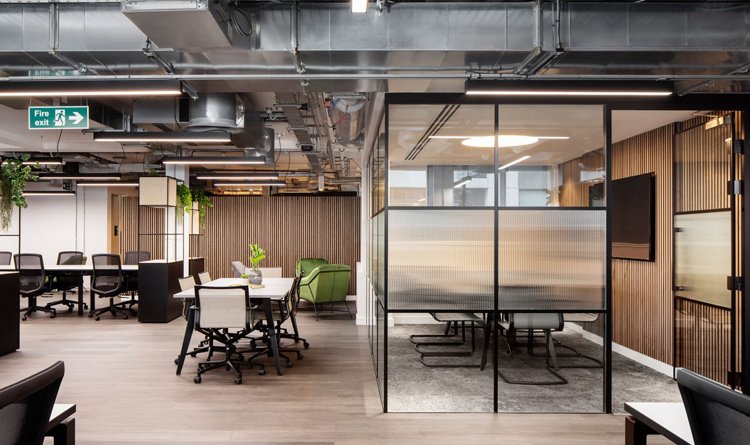
Your Guide To Services Offices vs Leasehold Offices
Choosing the right office space is a significant decision for any business. With workspace costs averaging around 20% of annual overheads, your office should work as hard as you do. At first glance, most offices feature four walls and essential amenities, making them seem quite similar. However, the key distinctions often lie in the terms and conditions of the leases you encounter.
Understanding the differences between leasehold, serviced, and coworking spaces can significantly impact your business; being locked into a lengthy lease could determine whether your company merely survives or truly thrives. This guide aims to clarify these differences and help you make a well-informed decision about your next workspace.
Serviced Offices vs Leasehold: Finding Your Perfect Workspace.

Coworking centres like WeWork have seen increased demand since the rise of hybrid working.
Coworking Spaces: Affordable Flexibility for Startups
According to the 2021 Census figures, 54.7 million people aged 16 and over in the UK are freelancers and digital nomads. Based on this data, approximately 7.4 million individuals are freelancing in the UK. So what is the concept of a coworking space, and how does it fit in? Toworking has evolved in recent years and has become a cornerstone for many entrepreneurs eager to establish their businesses. Coworking spaces have become a lifeline for many small businesses and digital nomads who thrive in a bustling environment, while other remote workers prefer tranquillity.
But why rent a coworking space instead of an office? Coworking spaces are considered by many to be the entry-level option for accessing physical office space on flexible terms. They achieve this by allowing members to pay only for what they need, when they need it. Instead of investing capital or reserving funds for a longer-term commitment, revenue can be focused on growing your business. Great if you have a short-term project or intend to scale the business. Shared workspaces, like WeWork, provide tenants access to desks, meeting rooms, and even social activities—all for a nominal fee.
The Advantages of Coworking Spaces:
Affordability: Coworking spaces are often the most budget-friendly option. With utilities, furniture, and IT equipment included, startups can save significantly. Coworking spaces are considered the most cost-effective solution for startup businesses. Long-term leases do not bind members, and they can start from a few hundred pounds per month.
Flexibility: Contracts are highly adaptable, allowing you to rent a desk for a day, week, or month, depending on your needs. Many coworking spaces are open 24/7. Meaning they offer flexibility in terms of work hours and location.
Networking Opportunities: Coworking spaces are a great place to meet other businesses and freelancers in a professional setting. From networking with members in the informal breakout areas to events (film nights with pizza and breakfast events are common), there are ample opportunities to connect with like-minded professionals.
Hassle-Free Management: The operator handles cleaning, recycling, and other services, leaving you free to focus on your work. If you are tired of complaining about tidying up the office and removing coffee cups at the end of the day, coworking spaces could be the answer! Many provide a complete cleaning service, including replenishing snacks, teas, and coffee stations, and ensuring the space is clean and tidy.
Wellness and Work-Life Balance: Coworking spaces are popular among startups, SMEs, and corporate companies that want access to a professional workspace away from home. Great for occasional use and for helping reduce loneliness, they provide a sense of separation from your home office and a chance to expand your network with like-minded professionals. Think of them as Work From Home Plus (WFT+).
Coworking Spaces Aren’t Everyone’s Cup of Tea
What are the disadvantages of coworking spaces? Let’s go through them…
Privacy Issues: Shared spaces make confidentiality challenging. Choosing a dedicated desk near a wall or window might help, but if you want to hold a meeting, you might be better off hiring a meeting room. Meeting rooms are sometimes included on a per-credit or hourly basis, but it’s essential to factor these in if privacy is important, as they can add to your costs.
Limited Branding: Without your own office, branding opportunities might be limited to your branded coffee cup, which can affect whether you are looking to promote your brand or leave a lasting first impression for a visiting client.
Potential Overcrowding: Coworking spaces can quickly become messy and noisy, except on Mondays and Fridays when many people work from home. This can be problematic, especially if you have important clients visiting your business. When choosing a coworking space, pay attention to the cleanliness of the kitchen and restrooms during your visit. Want a pro tip? Of course you do! Schedule your tour during lunchtime. This is when the communal areas are busiest, giving you a clearer idea of how well the onsite community team maintains the space.
Onsite Security: Some users of coworking spaces have commented that sharing the same workspace with different individuals and companies increases security risks. However, many established coworking spaces have strong security measures. They use CCTV, secure access, physical security, and protocols to protect sensitive information, such as network security.
The Definition of a Serviced Office: Convenience with Flexibility

Many serviced offices offer a personalised welcome and reception services.
What is the difference between a serviced office and a coworking space? Serviced office spaces in London are fully equipped workspaces available on short—to medium-term leases. They are advertised as being a license agreement rather than a lease. They offer a turnkey solution that enables businesses to move in and start operating immediately.
The Key Advantages of Serviced Offices:
Scalability: Monthly contracts make scaling up or down easy. If space isn’t readily available within your building, space might be available nearby within an adjacent building. Some workspace providers have a greater reach and network of buildings (especially in London), so it’s worth noting if you see the team growing within the next 6-12 months.
All-Inclusive Services: Utilities, internet, receptionist services, and maintenance are included in the monthly rental agreement. This is an essential factor to consider when comparing options, especially if you’re weighing costs and considering leasing space in an older building. It’s wise to understand if the landlord has any work planned to upgrade the air conditioning or refurbish the premises. It is worth noting that tenants may be asked to contribute to the cost of these works through their service charge.
Quick Setup: Infrastructure is already in place, making your move easier. Meeting rooms fitted with the latest tech —tick. No investment is needed on your behalf. Just pick a centre that has the tech and amenities that you need.
Low Initial Costs: Skip the expenses of furnishing and partitioning your office space. Photocopying and printing are often included, so that’s one less expense to factor in when buying. An example of this is a WeWork private office.
Hassle-Free Management: Providers efficiently manage cleaning, repairs, and utilities, helping reduce your administrative responsibilities. We also include ongoing maintenance for your convenience.
Shared Facilities: Amenities such as meeting rooms and kitchens are typically included. If a sink gets blocked or the AC decides to pack up in the height of the long British summertime (what’s that!), you’re not lumbered with an expensive bill to repair it.
Free Upgrades Included: Leasing equipment such as photocopiers and coffee machines means you’ll always have the latest kit. You can leave the competition of having the best coffee machine and keeping up with the Joneses to others, allowing you to concentrate on what truly matters—your business.
Considerations for Serviced Offices:
Higher Monthly Costs: Serviced offices come with higher monthly fees than traditional leases, reflecting the all-inclusive nature of their packages, which cover utilities, furniture, and cleaning. While they can be cost-effective for short-term arrangements, businesses looking for long-term solutions may find these costs add up. Companies prioritising budget predictability might benefit by prioritising leasehold options.
Limited Customisation: Serviced offices are typically pre-customised and ready to move in, which can limit personalisation. In contrast to leasehold offices, personalisation control over layout and branding, serviced offices often have a uniform aesthetic. This can be a challenge for businesses seeking a workspace that reflects their brand identity or meets specific operational needs, such as tailored breakout areas.
Shared Spaces: In a serviced office setup, facilities such as kitchens, reception areas, and meeting rooms are shared. While they encourage networking, they raise concerns about privacy and exclusivity. Sensitive meetings may require booking private spaces, while shared environments can lead to distractions and resource competition, which may be a drawback for businesses that prioritise privacy or need exclusive facilities.
Prioritise: Not Forgetting Classic Leasehold Office

Leasehold offices tend to offer more sq. ft. per person vs paying per desk.
A leasehold office is a commercial property rented under a lease agreement, typically for 3, 5, or even 10 years. In recent years, lease terms have decreased dramatically to encourage tenants to lease office space rather than rent serviced offices. Although this has reduced since the pandemic, many businesses have been slower to return to leasing office space as some ended up trapped with the commitment of a longer-term lease but unable to access it due to workspace restrictions imposed by COVID. The leasehold option suits businesses looking to create a bespoke workspace. Depending on the level of investment you wish to take, you are responsible for everything from finding the space, appointing a commercial agent, and securing legal representation, to choosing the office fit-out, furniture options, and ongoing maintenance of the toilets and air-conditioning system, and dilapidations upon exit.
There’s More to Leasing an Office Than Just The Lease
Design Your Own Office: Do you want complete control over your office design? If so, leasing an office allows you to achieve that. Leasehold offices are ideal if you want your workspace to reflect your brand and culture.
Direct Landlord Relationships: Negotiations and agreements are handled directly with the property owner or agent —so play nice!
A Quick Word on Short-Form Leases: A short-form lease is a simplified version of a standard lease agreement that outlines the main terms and conditions between a landlord and tenant. Short-term leases are often used to save time and omit details. A traditional commercial lease is more extensive and has fixed terms. Generally, they are set periods but usually include break clauses or renewal options.
Leasehold Offices: They Do Have Their Advantages:
Cost Efficiency Over Time: Although initial costs may be high, long-term leases often prove more economical. This is particularly true for renting office space in London—and in other locations as well—since maintaining a stable occupancy within a building is more beneficial for office space providers than constantly accommodating new tenants.
Exclusive Use: Experience privacy and complete control over your workspace. This is ideal if you want a personalised reception for visiting clients. Transform the space to reflect your vision. If you desire customisations, do it! You have the power to shape your working environment; it’s just a case of having the budget and the right tradespeople to bring your ideas to life.
Size of Space: Leased offices typically offer more space than serviced offices, averaging around 100–150 square feet per employee. In contrast, serviced offices generally provide less room, averaging 35–50 square feet per employee. This difference arises because serviced offices offer amenities all-inclusive, eliminating the need to incorporate them into each workspace.
Things to Consider for Leasehold Office Space:
Upfront Costs: Leasing office space often involves significant initial expenses beyond the monthly rent. Businesses must budget for furniture, fit-outs, IT infrastructure, and possibly renovations to tailor the space to their needs. Additionally, deposits and legal fees can add to the upfront financial burden, making it essential to assess overall affordability before committing.
Maintenance Responsibilities: Unlike serviced offices, where upkeep is often included, leasehold agreements typically place the responsibility for repairs and maintenance on the tenant. This includes handling utilities, structural repairs, and general wear and tear, which can result in unforeseen expenses. Tenants must also manage regular cleaning and compliance with building regulations, adding to the workload and operational costs.
Long-Term Commitment: Leasehold agreements often require tenants to commit for terms ranging from 5 to 10 years or more. While this can provide stability, it may not suit businesses with fluctuating headcounts, evolving operational needs, or expansion plans. Breaking a lease early can be costly and complicated, so companies with unpredictable growth should weigh the risks carefully.
A Word on Subleasing: The Alternative Option
Subleasing is an increasingly popular option for businesses looking to save costs or secure flexible office space. This arrangement allows you to rent part of a leased office from another tenant, providing opportunities to share expenses and avoid the larger financial commitments of a direct lease. However, it’s essential to approach subleasing with due diligence to ensure it aligns with your business needs and avoids potential complications.
Landlord Approval: Subleasing typically requires written landlord consent. Without it, you risk violating the original lease terms. The landlord may review the sublease agreement and assess your business suitability before granting permission.
Lease Restrictions: Not all leases allow subleasing, and some may have restrictions on subtenants or terms. Review the original lease to identify any conditions that could lead to legal disputes and ensure compliance with the landlord’s expectations.
Liability: Even while subleasing, the primary tenant is still responsible for the original lease obligations. If the subtenant fails to pay rent or damages the property, the primary tenant must address these issues. If you’re subleasing, have a solid legal agreement to protect yourself from potential risks.
Subleasing can be a practical solution for businesses seeking temporary or smaller spaces without committing to a longer-term lease.
CAT A+ / Managed Offices: The Best of Both Worlds

MetSpace offers a bespoke service and CAT A+ workspaces to rent on flexible terms.
Managed offices, often referred to as CAT A+ spaces, strike the perfect balance between the control of leasehold offices and the convenience of serviced spaces. These offices offer businesses the opportunity to customise their workspace while enjoying the flexibility of shorter-term, hassle-free management. This hybrid approach makes CAT A+ offices a popular choice for companies seeking a personalised yet low-maintenance solution.
Key Feapersonalised A+ / ManagedpersonalisedCustomisation: CAT A+ offices offer the advantage of customising the space, our brand, and the space itself. From layocustomisingons that promote collaboration to the personalisation of company colours and logos, these offices offer a high level of customisation. This creates an environment that enables you to extend your customisation out of the long-term commitment of a traditional lease.
✔ All-Inclusive Payments: Choose CAT A+ offices for a seamless budgeting experience that streamlines your financial planning. With a single monthly fee that covers rent, utilities, internet, building management, and essential amenities, you gain unparalleled cost transparency. This all-inclusive model not only simplifies your expenses but also frees you from the complexities of managing multiple service providers, allowing you to focus on what truly matters – your business.
✔ No Upfront Costs: One of the key advantages of CAT A+ offices is that providers handle all the setup, including furniture, fit-outs, and IT infrastructure. Businesses can move into a fully operational workspace without incurring the high upfront costs associated with traditional leases. This is particularly appealing for companies looking to scale quickly or preserve cash flow for other priorities.
Why Choose a Managed Office?
Managed offices are ideal for businesses seeking a bespoke workspace without the long-term commitment of a leasehold arrangement. They provide more established businesses with a balance of flexibility and control, making them a popular choice for scaling companies.
Leasehold vs. Serviced Offices: Weigh Your Options and Find Your Perfect Workspace Today
Navigating the differences between leasehold, serviced, and managed offices is crucial to selecting the workspace that best meets your specific needs. Each option comes with its own set of advantages and challenges, making them suitable for various business requirements. By assessing your priorities, budget, and future growth plans, you can choose a workspace that perfectly aligns with your objectives. Whether you seek flexibility, customisation, or long-term cost savings, a tailored solution awaits your business. From startups to established corporations in search of a new headquarters, we’re dedicated to helping you evaluate your leasehold versus serviced office or coworking possibilities. We’ll take the time to understand your unique needs and preferences. There’s no obligation or fee for the initial consultation, but with the insights you gain, you’ll be empowered to negotiate the best possible terms for your next office space.



